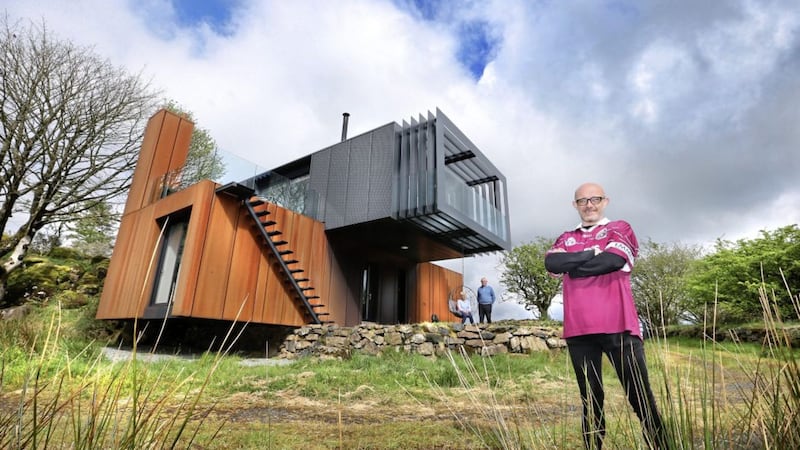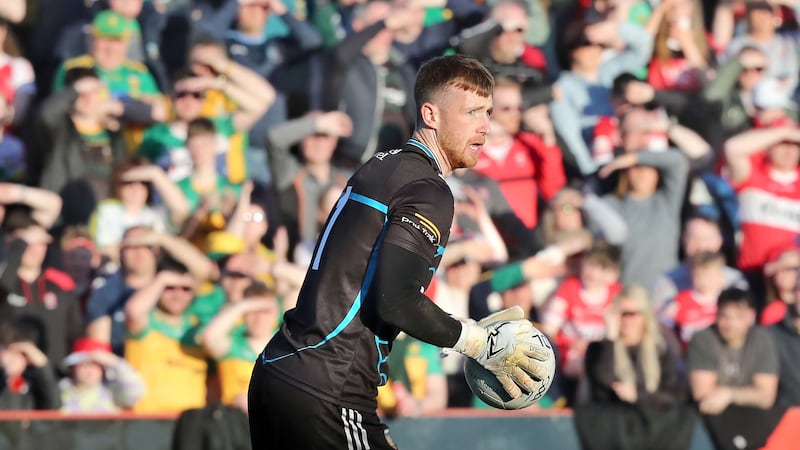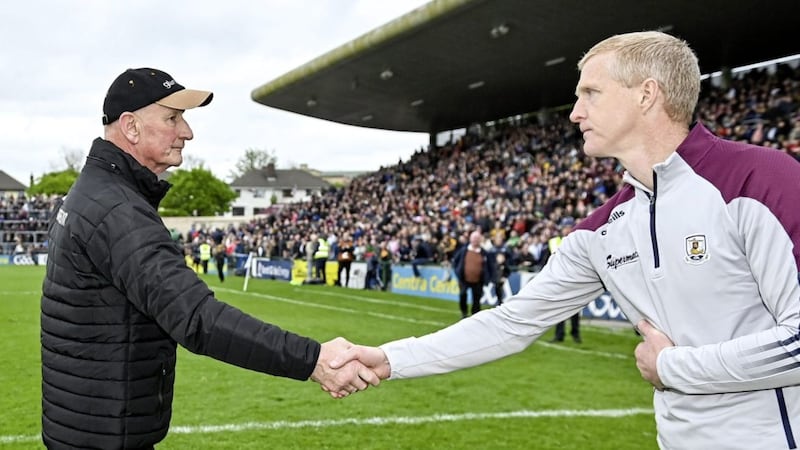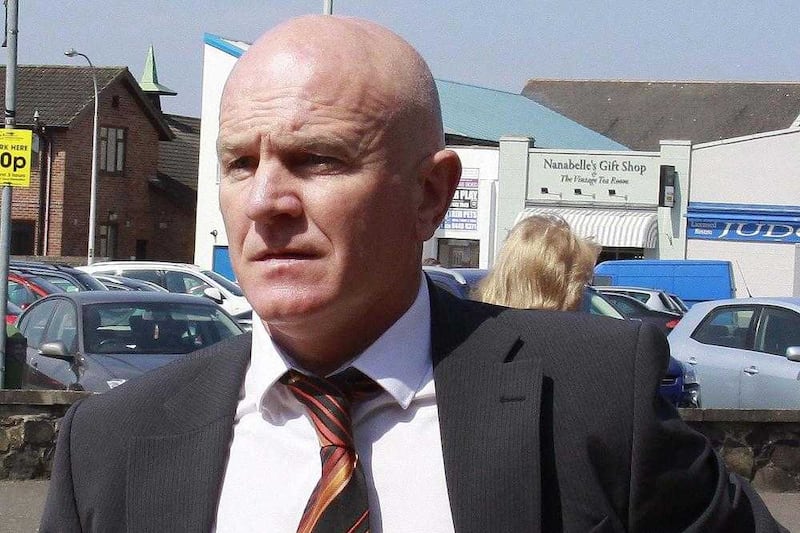GENIUS among the whin bushes. A house, now a family home, created out of shipping containers on a farm in Slaughtneil, county Derry.
The architect was Patrick Bradley, winner of Channel 4’s Grand Designs, and a man totally rooted to the place he has always called home. I’d marvelled at his creativity on the telly but I didn’t know if he’d ever played sport, or had any interest in it, before I rang to ask him.
“Sure aren’t I from Slaughtneil, boss? How could I not?” he answers in a thick Derry accent and we take it from there.
It turns out that there was a time, before injuries took their toll and cantilevers and collonades replaced the ball and the sliothar in his keen imagination, when hurling and football were the twin drivers of his existence.
“It was all I dreamt off,” he says. “And I loved every minute of it.”
“I played from whatever time you start: Six? Eight? Up to senior and I would have played on for my lifetime if I could.”
Patrick and the other Bradleys (he’s a cousin of Derry midfielder Patsy but never considered himself a county prospect) and McEldowneys who inhabit their beautiful part of the world are all from the same clan. A flock of them came through for the Robert Emmet’s in the 1980s and ’90s, swelling the ranks of a club with grand designs of its own.
Victory in the prestigious St Paul’s minor tournament in 1998 was the breakthrough win that many credit with kick-starting the extraordinary success of a club that is now a dominant force in Ulster in camogie, hurling and football.
“Jeeee-sus, that’s a long time ago now,” says Patrick, who turns 40 this month.
“Gavin Devlin (later to star for Tyrone) marked me in the final that day for Ardboe. I see him an odd time now and I always say to him: ‘Well Horse, I scored four points off ye at St Paul’s! What happened ye that day?’
“But he went a lot further than me. He won All-Irelands, I won the St Paul’s tournament… Ah, but I’m happy enough with it.”
It’s no surprise that he played at centre half-forward as a creative free-spirit in that minor team. He looked destined to go on to have a long senior career with the club but unfortunately he wasn’t built that way.
Shortly after the St Paul’s victory, his hamstrings started to “rip and nip” and the first of three cruciate injuries came not long after. He returned, but too quickly and a pattern of injury-recovery-injury began.
“I was silly,” he says.
“I never gave it time to heal, I thought I was invincible and I came back and wrecked it again. Everybody knows about my hamstrings – I had wild-bad hamstrings – every other match they went and it just got depressing.”
The cruciate went twice in one knee and once in the other but each time he patched himself up and soldiered on until the tipping point came in a league game against Ballinderry at Shamrock Park. John Brennan, the man who guided the club to a first senior title in Derry in 2004, was the manager then.
“Kevin McGuckin was marking me and a ball came in, I got it and I mind turning Kevin and put it over the bar and ripped my hamstring,” he recalls.
“I played on for another 10 minutes and then I said: ‘Right, that’s it, enough is enough’. I had the cruciates and I knew the hamstrings weren’t going to get any better. That was it.”
He limped off Shamrock Park that day with tears in his eyes knowing deep down that it was all over. When you’re young enough to play but you can’t, it’s hard to be a spectator and watching his team-mates go on without him was soul-destroying.
“There is nothing better than playing for your club,” he says.
“The two or three years after I had to quit I’d say were the hardest of my life.
“I missed everything about it. I missed the smell of the changing rooms even… it’s weird and then you have to sit back and watch the boys go on and you’re sorta half thinking you could have done better and you wish you had have done this or that. But sometimes your body’s just not for it and mine wasn’t, that’s the way it was.”
One door shuts and another opens. There was a void to fill and into it poured what has become his life’s work.
“Everything happens for a reason,” he says.
“You go from one thing into another. I got into the architecture and it took on a life of its own. I get wild-obsessed with what I do so after that I just went into architecture and I got completely and utterly crazy-obsessed with it.”
He’d done well at school and he’d always had an interest in architecture but when he enrolled on the six-year degree course at Queen’s University, interest developed into passion and passion became an all-consuming obsession.
“When you’re growing up near a GAA ground it’s: football, football, hurling, hurling, football, football…,” he says
“Like any other young boy growing up, you’re just running round and having the craic, I didn’t care much about studying but once I got into Queen’s I actually went full-bore at it – completely mad, obsessive and everything just kicked off from there.
“I lived with guys from round Slaughtneil in the house and played a bit of football with them but when they partied, I worked.
“I never really went out and partied when I was at university. In one sense, it’s a regret but on the other hand I maybe wouldn’t have got where I have, if I had. It was a heavy, heavy course. I used to do all-nighters and I mean all-night… One of the worst ones was with a great friend of mine and we went nearly seven days without sleep.
“It was my final submission, making models and drawings for a woodland eco centre in Bangor. We lived off coffee and Red Bull and how we didn’t die I don’t know. The sixth year in university in those days wasn’t for the light-hearted. There was about 90 people in my class when I started university and seven of us made it to the sixth year.”
A degree course that sounds more like a Navy Seals induction eventually ended with smiles on graduation day and Bradley engaged his head-full of innovative ideas out in the real world and began work for Consarc Conservation.
A career he says he’ll “never see as a job” began as a conservation architect on listed buildings including Castle Leslie but commuting from Slaughtneil to Belfast did not agree with him and so he moved closer to home; to McGurk architects in Magherafelt. During his time there he designed the Derry Centre of Excellence in Owenbeg.
At the same time he was doing “wee bits and bobs… crazy houses and stuff” of his own and, as personal projects increased, he converted his father’s garage into an office and set out on his own. The seed of idea – to build an amazing house surrounded by the waters and the wild - took root in his brain during time spent on the farm and it grew and developed and took hold of him.
And then… Grand Designs, the highly-addictive Channel 4 series which showcases unique home-building projects that often appear to come from what presenter Kevin McCloud describes as: “The realm of the lunatic”.
“I didn’t go on Grand Designs to be on TV because I don’t give a f**k about that shit,” says Patrick.
“I went on it to see if I could get a house built cheaper with suppliers. That was my plan but I didn’t get anywhere because we were just coming out of a recession and nobody was interested!
“Grand Designs vetted me over the phone and the guy says to me: ‘Are you for real?’ I asked him what did he mean? He says: ‘I see the stuff you’re doing here and you’re working out of your da’s garage and working on a farm’. I says: ‘What’s that got to do with it? The last time I checked it was real’.”
It turned out that the Grand Designs researchers get sent around 500 houses every week from people hoping to feature on the show. Out of those, 10 projects are shortlisted and a handful are actually filmed. Lo and behold, the production crew paid a visit to the Bradley family farm.
The producer said to me: ‘You’re an eccentric’ and I told him: ‘I take that as a compliment’. The craic went well and he told me I would be on the show.
“I lived my life, did my work and worked on the farm and then Grand Designs came on board,” he explains.
“We built the house and it was great. I got to meet Kev (presenter McCloud) because I’d watched every episode of Grand Designs there ever was. If it’s not architecture or sport, I don’t watch it.”
The week before the programme aired, the production team were in touch to warn him that things could “go crazy” afterwards and they were absolutely right.
The amazing home he had created from a pair of criss-crossed shipping containers dropped into the Derry countryside as if from outer space, yet ingeniously designed to look as natural and at home in Slaughtneil as their designer, made him a global star in architecture overnight.
“Once the programme went out it was… chaos,” he says.
“My phone never stopped, my email crashed because I was getting thousands and thousands of emails a day about houses from all over the world.
“That spell, to be honest, was a bad spell for me. I nearly went into a depression because I couldn’t get work done, I couldn’t control it.
“I mind turning the phone off and sitting for two full days just deleting emails.”
For a man who was used to working alone in his office or on the farm, it was system overload. Offers of work piled up but he decided he would take on only what interested him and he has found his own contented groove since. It seems that if you’re after a four-bed bungalow with a kitchen and two reception rooms, Patrick might not be the man for your job.
“I have a philosophy that if I’m going to design a house, I need to get on with the client,” he explains.
“We need to have a great relationship and they need to tell me absolutely everything about themselves personally so I can design around it.
“I like to get into the head of a client from their morning coffee to what time they go to bed, what side of the bed they lie on, what way they entertain, do they do sports… I design around the way they live, rather than the accommodation and before they know it they have a house.
“Good design is not about saying: ‘I want so many bedrooms’. Yes, they’re going to get bedrooms but they’re going to be bedrooms with a purpose.
“It’s about designing a glove to fit the way you live your life, rather than you trying to fit your life into a glove.”
Maybe it’s the well-heeled who live in the homes he designs but Bradley is a committed advocate for the homeless and he recently raffled a weekend stay in his home, raising thousands of pounds for the Simon Community.
“I don’t believe in hierarchy of people,” he says.
“I talk to everybody the same, I don’t care who you are or what you are and I think everybody is entitled to a house, no matter how big or small it is.”
His grandest design yet arrived four weeks ago when his wife Victoria – she’s originally from South Africa and they met in London when he ran a practice in Chelsea - gave birth to baby Eve. Perhaps she’ll be future camogie star for the Emmets and have better luck with her hamstrings?
“I’m sure Eve will go up and swing a stick and if she’s good, she’s good; if she’s not, she’s not,” he says.
“As long as she’s there and she’s part of it, that’s what it’s all about.
“I sat down one night there to watch the Waterford and Cork Munster final (the one John Mullane got sent off in) and I smiled and thought about the first time I watched it. I go across to my da (James) and we sit and watch all them big matches; it’s one of our things. We go to every match together and we have been doing that since I quit the football
“But there’s nothing will beat the club and I think we are blessed. The GAA is great for times like this; that camaraderie when we pull together. It’s a family and the sport is just a bonus on it.
“I’ve travelled a bit and they don’t get the GAA. Even Victoria says: ‘They don’t have this anywhere else in the world’.
“People don’t understand it but she sees it now and you have to live in it to experience it.
“Wherever you are, you could meet somebody from Ireland and you’ll be talking about football before you talk about anything else. To be able to do that anywhere in the world is brilliant.
“The GAA is a starting-point and ending-point for every conversation and, I tell you what, it brings us closer together no matter how far we are apart.”
Yes, it’s our genius among the whin bushes.




